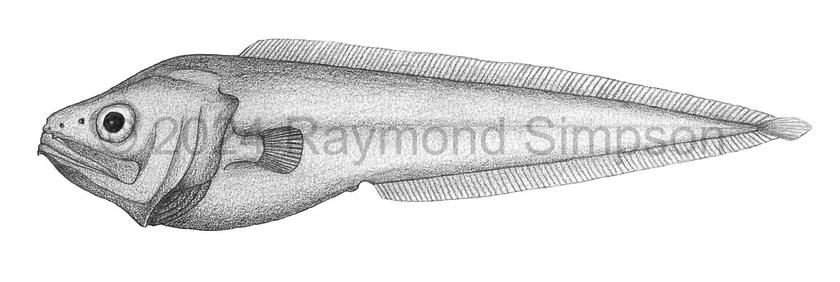
Common Name
Shorttail Cusk-eel
Year Described
Cohen, 1974
Identification
Dorsal Fin: 79-84
Anal Fin: 58-64
Pectoral Fin: 21-24
Caudal Fin: 9
Pelvic Fin: 0
Gill Rakers: 3+1+10-12 on first arch (tubercles)
Vertebrae: 63-66 (total)
Head very large with a short, stubby tail (head 3.2-4.5 times in SL). Mouth large, extending well past orbit. Snout longer than eye. Maxilla expanded rearward. Teeth present in vomer, palatine, dentary, and premaxilla. Opercle with no spine. No median basibranchial tooth patch. Head pores and canals well developed. Gill rakers with spiny tubercles. Pelvic fin absent. Body and head fully scaled except for belly, branchial area, snout, upper jaw, and fins. Scales are randomly distributed star-shaped prickles. Otoliths very small and round.
Larvae with dramatic sail-like dorsal and anal fins but stumpier than congeners. Related to Lamprogrammus larvae but without extended gut.
Color
Body dark brown to black with a purplish belly. Head usually dark. Fins dark with a paler margin. Young fish paler with 5-7 dusky blotches on side.
Size
Maximum size to 320mm SL.
Habitat
Captured in midwater between 600-2650m.
Range
Bermuda to the Gulf of Mexico to northern South America. Also the central and eastern Atlantic.
References
Cohen, D. M. 1974. A review of the pelagic ophidioid fish genus Brotulataenia with descriptions of two new species. Zoological Journal of the Linnean Society, 55(2), 119-149.
Fahay, M. P., & J. G. Nielsen. 2003. Ontogenetic evidence supporting a relationship between Brotulotaenia and Lamprogrammus (Ophidiiformes: Ophidiidae) based on the morphology of exterilium and rubaniform larvae. Ichthyological Research, 50, 209-220.